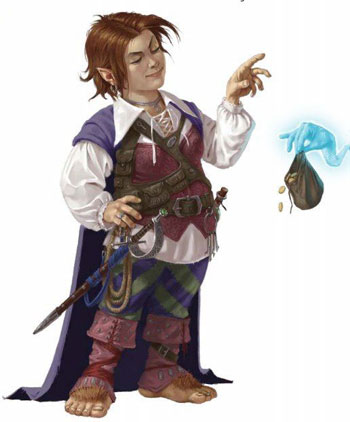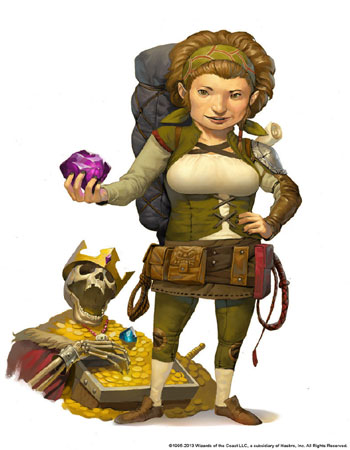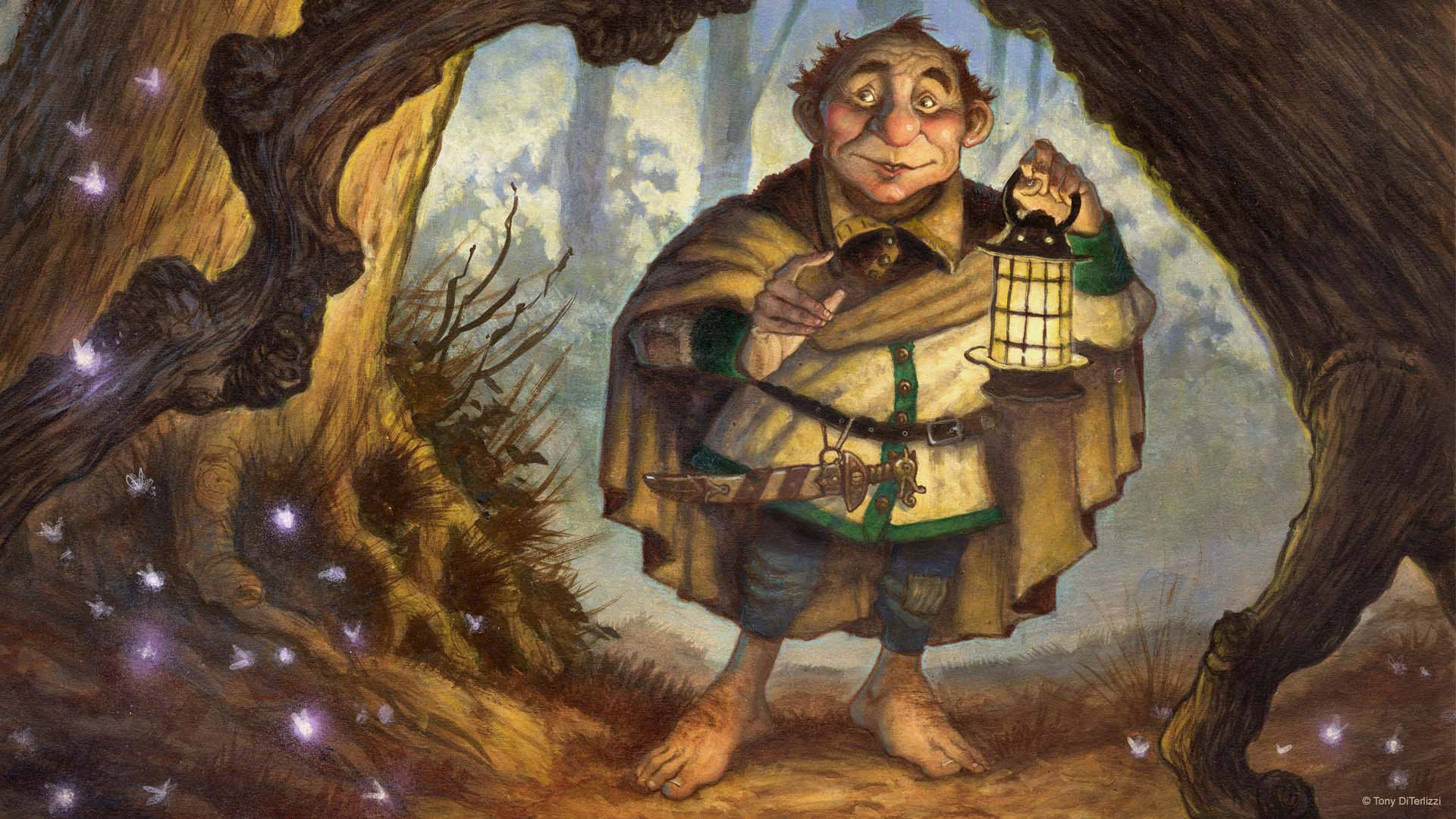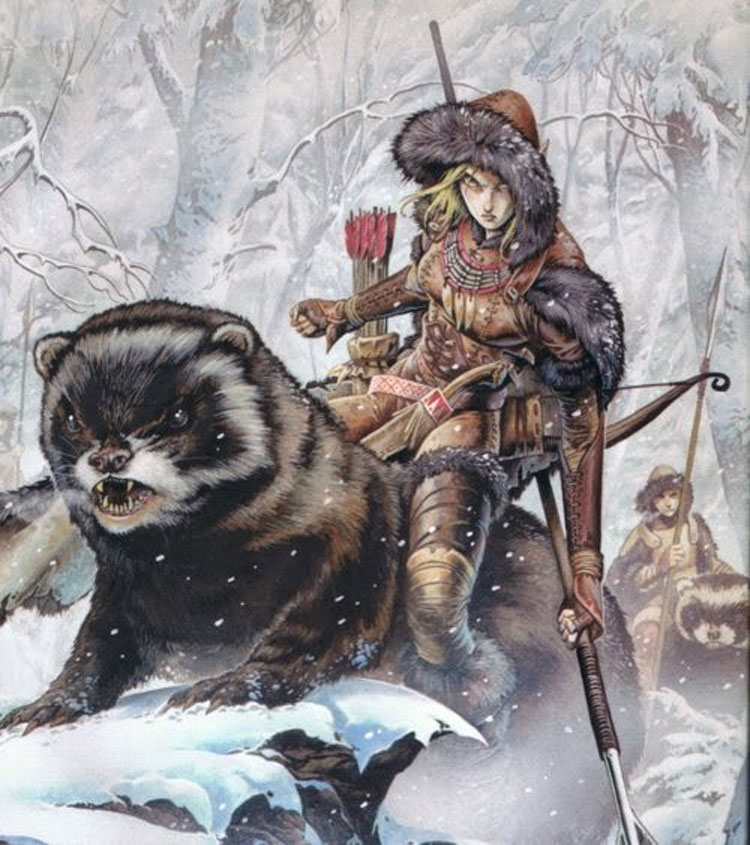Lightfoot Halfling
Physical characteristics
A typical lightfoot halfling stands around three feet tall and weighs around 35 to 40 pounds. Their skin colors range from light pink to slightly reddish or bronze, and their hair color is typically auburn, brown or black. Males usually wear their hair short on the sides, often with a mullet or bowl cut. Facial hair among males is rare except for extremely old halflings. Females rarely allow their hair to grow beyond shoulder length. When not adventuring or entertaining others, halflings prefer simple, well-made clothes that are comfortable to wear yet look attractive.
Psychology
The impression a lightfoot halfling always tries to project is that of a mirthful, friendly individual who is always interested in making new friends. Sometimes this light-hearted attitude is genuine, but other times it is a facade to lull people into a false sense of security so that they might reveal secrets that would benefit the halfling. Halflings are extremely social towards their own kind and tend to form neighborhoods within cities they inhabit, both for companionship and for mutual protection. While not exactly greedy, halflings do enjoy wealth and respect the power and pleasures that it can bring. However, they are careful not to let greed compromise themselves or their society. In addition to information gathering, many halflings become collectors of different objects, ranging from mundane items like books or weapons to more exotic interests such as artifacts and other ancient secrets.
Homelands
Lightfoots are, by nature, wanderers, and so can rarely be found tied down to one place for very long. Typically, lightfoot halfling clans move from one area to another rapidly, staying in one place rarely more than a year or two. There are exceptions to this rule, however, and in spite of their curiosity and adventurousness, some halflings are drawn to their ancestral homeland of Luirenhill in southern Aldwynne. Others merely settle more permanently in some foreign land, usually human. Still, it cannot truly be said that lightfoot halflings have any land of their own; instead, they call the whole world their home. They are at home living side by side with folk of many different races and cultures.
Some lightfoot halflings are wandering traders, craftsfolk, and entertainers. A clan of several extended families may settle in a human town for a year or two, working and trading, and then pick up their stakes and move on for reasons known only to themselves. However, many lightfoot halflings prefer a more sedentary existence and will sometimes put down roots in a human settlement they prefer.
History
Most lightfoot halflings trace their family ancestry back to the days when a great tribe of their subrace populated the territory known today as Aldwynne.
Hundreds of years ago, Aldwynne was an unsettled wilderness roamed by two great halfling tribes: the lightfoots, and the stouts. The two races fiercely defended their grasslands against all intruders for centuries, driving off Fjoll barbarians, packs of rabid gnolls, and sharing the Lluirhill’s resources. Feuds between these two tribes were not uncommon, but for the most part the two tribes lived in peace.
Around 1978, an evil spirit set foot upon the Lluirhills. Under the leadership of a powerful cleric named Desva, a part of the lightfoot halflings fell into darkness, worshiping Garagos and glorifying in violence and bloodshed. Feral lightfoot hunters, their faces painted like skulls, prowled the hills in search of halfling prey. They grew ever stronger as Desva led them deeper into Garagos’ worship, teaching the greatest hunters to take shapes as werewolves and poisoning the Lluirhill’s natural predators with maddening bloodlust. For a generation the Lluirhill was a place of death.
In 2002, a stout hunter named Chand became war chief of his folk and struck an alliance with the war chief of the lightfoot tribe. The two united to root out the madness of the Garagos halflings. Over three years each Garagos stronghold and lair was found out and destroyed, until Chand himself slew Desva of the Garagos halflings in 2005. The fighting was merciless and awful — entire Garagos halfling villages were burned and their folk killed. Chand held to his purpose and saw to it that no hin warrior stayed his or her hand. In the aftermath of the Hin Garagos Wars, the Garagos halflings were eradicated.
Many of the lightfoots, horrified by what Chand and the stouts had done, chose to leave the Lluirhill. The lightfoot halflings departed their homeland and spread out across Abios in a great diaspora. Though some lightfoot halflings remained in Aldwynne, the subrace has become ubiquitous throughout the settled lands of Abios.
They became a nomadic people spread across all of Abios, adopting the customs and traditions of the folk they traveled among.
The stouts remained in the Lluirhill. Unchecked by the lightfoot ways, they began to tame the hills and grasslands and settled in semi-permanent villages that grew larger and more permanent with each passing generation. They changed from nomads to settled farmers and craftsfolk, defending their lands against numerous invasions and raids over the years. In time, some lightfoots returned to the new realm of Aldwynne, but this is now a stout hin's land.
Outlook
Lightfoot halflings may be the most common of all the subraces, but their behavior is also the most varied. It’s impossible to describe the “typical” lightfoot halfling because, much like humans, the race embodies individuals that are the absolute antithesis of one another. This diversity of behavior is mirrored in a diversity of outlooks: Some halflings adopt views and beliefs about the world that are very close or even identical to whatever human community they happen to dwell in, while others retain distinctive points of view that separate them from other races and groups (including other halflings). It’s not uncommon to meet halflings who, because they spend the greater part of their lives roaming from place to place, have outlooks that are amalgams of those from multiple cultures and environments.
The aspect of the lightfoot outlook that most non-halflings notice, however, is that they are the hin subrace that is most likely to wander out of an innate desire. It is not unknown for individual lightfoot halflings or even entire families to decide that, after living in the same place for decades, they want to move on to someplace else. Some learned folk speculate that the lightfoot hin experience a habitual need to see many different places and enjoy a variety of experiences. Other sages and loremasters wonder if the lightfoot penchant for the semi-nomadic lifestyle is socialized behavior, learned from centuries of practice. These scholars theorize that the lightfoot hin who left Aldwynne because of the Garagos War massacres were unable to find a new homeland that suited them as well, so they wandered. After so many hundreds of years of wanderings, the behavior is now natural to the lightfoot hin, or so this school of thought holds. Whatever the case, there’s no denying that many lightfoot halflings seem determined to see a great deal of Abios and have many interesting experiences during their lifetimes.
Lightfoot Halfling Characters
As befits their name, lightfoot halflings often take classes that work well for wanderers, such as rogue and bard. Lightfoot halflings often pick up an impressive array of skills during their travels, and with their small size and low strength, they need the advantages of stealth and cleverness.
Lightfoot Halfling Society
Lightfoot halfling society is hard to quantify, because lightfoots can be divided into three groups: those who live among humans, those who live among other lightfoots, and those who wander from place to place. Some lightfoot halfling families live their entire lives in one place, sometimes as part of a human community, and sometimes in a settlement populated almost entirely by halflings. Others live their entire lives on the roads and byways of Abios, never remaining in one place very long.
Language and Literacy
Lightfoots speak Halfling, Common, and the language of their home region—which, given lightfoot wanderlust, could be almost anywhere. Wandering lightfoot halflings pick up the languages of the places they live, and often learn other widely spread tongues.
Lightfoot Halfling Magic and Lore
Lightfoot halflings tend to be generalists when it comes to magic, using a broad array of spells and magic items to make their travels—or their hearths—more pleasant. They are skillful clerics and sorcerers, but sometimes lack the discipline to become accomplished as wizards.
Spells and Spellcasting
Because they’re almost always fighting foes who are larger than they are, lightfoot halflings favor spells that help them move around the battlefield and negate the physical strength of their foes. Expeditious retreat, fly, haste, various polymorph spells, and especially Evard’s black tentacles are common spells in a halfling spellcaster’s arsenal.
Lightfoot Halfling Deities
The diversity evident in the lightfoot halflings’ outlook and society is also reflected in their religious beliefs. Of all the hin subraces, the lightfoot are the most likely to worship deities other than those belonging to Yondalla's Children. In addition to the deity they most favor, many lightfoot households—particularly those that prefer life on the road to a more settled existence— often venerate a household patron, often inspired by some matriarch or patriarch in the family’s history.
Sehanine Moonbow, the Moonlit Mystery, is much beloved by the lightfoot hin for her practical view of stealth and keeping secrets. Sehanine is a common patron deity of those halflings who trust to their ability to remain hidden and safe to see them through as they wander from place to place. The worship of Sheela Peryroyl, the Watchful Mother, is wildly popular among lightfoot halflings born within the last two generations. Her message of the balance between the tamed earth of agricultural civilization and the verdant growth of the wild has fallen on receptive ears. The ranks of her clergy have swelled with the number of lightfoot hin seeking to spread her message and contribute to the search for a new lightfoot homeland. Yondalla’s faith is popular with the lightfoot halflings, both those who wander and those who prefer to settle in more permanent communities.
Lightfoot Animals and Pets
Lightfoot halflings make up for their small stature by domesticating some of the largest and most powerful animals in Abios. A towering human brigand has a hard time pushing around a halfling traveler with a pair of loyal hounds or a bear at her side.
Encompassed species
Player Character Stats
As a lightfoot halfling, you can easily hide from notice, even using other people as cover. You’re inclined to be affable and get along well with others. In the Forgotten Realms, lightfoot halflings have spread the farthest and thus are the most common variety.
Lightfoots are more prone to wanderlust than other halflings, and often dwell alongside other races or take up a nomadic life. In the world of Greyhawk, these halflings are called hairfeet or tallfellows.
Your Charisma score increases by 1.
You can attempt to hide even when you are obscured only by a creature that is at least one size larger than you.







Comments